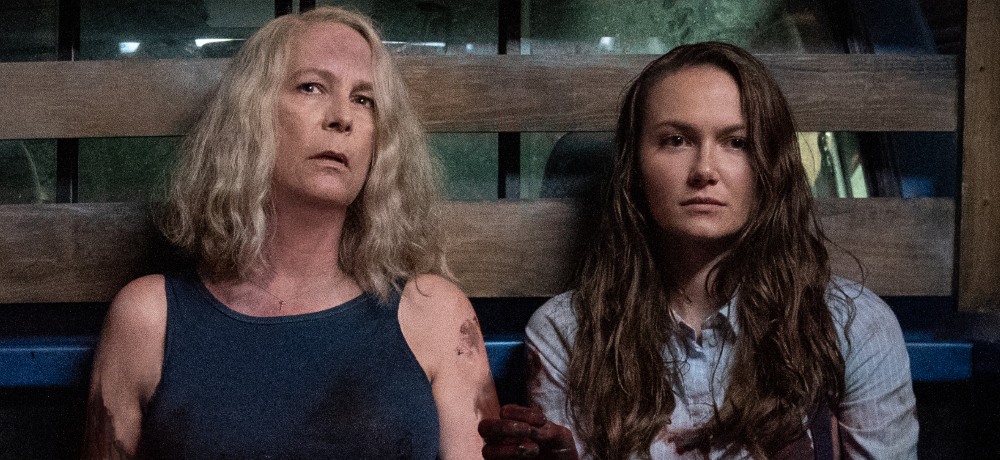


With the release of Halloween Kills just right around the corner, we have a roundtable interview featuring both Jamie Lee Curtis and Andi Matichak to get all of you Halloween fans ready for the sequel’s arrival in theaters and on Peacock on October 15th. During the discussion with the Halloween Kills co-stars, both Matichak and Curtis discussed their experiences returning for the follow-up film to Halloween (2018), how their characters and their relationships have evolved throughout the two movies, as well as their thoughts on what it means to be a final girl in 2021.
What was Halloween Kills like for you from a creative standpoint, in comparison to Halloween (2018)?
Andi Matichak: It was a really fun jump to go directly from the 2018 movie directly into Halloween Kills. There wasn't much time lost. You immediately pick back up and you're starting at 150 miles an hour and you just keep your foot on the accelerator all the way through the end. I'm fortunate that I had a director like David Gordon Green that was able to guide me through these transitions that happen so quickly for a young person, like Allyson, to be literally in school that afternoon, and then picking up a gun and going to hunt Michael Myers down and how to make that honest and true and grounded in a way that felt accessible and real. I was very fortunate to have David Gordon Green and what he brought to the table in order to help me make that curve.
Jamie Lee Curtis: And of course, I'm in a hospital gown for half the movie. Thank you very much, everyone.
Andi Matichak: You look damn good in it, though.
Jamie Lee Curtis: No, I do not look good in it. Nobody looks good in a hospital gown. It's the truth. And so it was very frustrating and difficult for me because you have to restrain yourself. It's a restrained time. She was a warrior and now she is rendered impotent and it was challenging for me. It was also frustrating because everybody else is having this experience out in the world and I don't leave the hospital. I'm in the truck and then I'm in the hospital for the rest of the movie. So it was challenging for me.
So much of the last film was about reclaiming your power after trauma, but in this one, of course, evil persists. And I was wondering if the two of you could discuss the challenges of maintaining that horrific history while the sequel must still go on?
Jamie Lee Curtis: Wow, that's a deep film school kind of question. I don't know, Andi. I would simply say that the beauty of these movies is that the past is irrelevant. That you're so in the present moment of each moment. Each moment leads to the next moment. And I just don't think there's a moment in this film. There is no time for thinking and for anybody. It is zero to 60, and it's 60 for the rest of the movie. It feels very high-octane, very frenzied. And I just don't think you’re carrying the past with you. The shock for Laurie that Michael's not dead is so palpable and real. And so, what do we do? We fight. It was intense. All of it was intense. That's all I can say is that there was no thinking for me. Andi?
Andi Matichak: I think that part of what made that a little bit easier is the fact that it's one continuous movement. It's basically a four-hour movie, more or less. If you then look at it that way, then you're picking up in Halloween Kills basically at the climax. And I think that there also was so much change that did happen between these characters, and that is lasting. You get to see them as a united family for the first time, so it's really nice to get to see these women genuinely leaning on each other, like they are in the back of this truck. Allyson definitely picks up the torch and goes out there because she's inspired by her grandmother and she wants to do it right, and do it when Laurie can't.
Throughout the movie, and even with the 2018 movie, there's this idea of passing the torch from Laurie to Karen and even to Allyson, as we see within Halloween Kills. I wanted to ask, what does this idea of the final girl mean to you in this current horror space?
Jamie Lee Curtis: Just so you know, I'm not a film nerd. I'm a film fan, but I'm not a fan of the genre, so I'm not knee-deep in it. I just participate in it. Prior to making these new Halloween films, I had a couple of years before I heard the words “final girl.” I had never heard the words “final girl” before. I didn't understand that there are textbooks that talk about final girls and chainsaws. I didn't really understand what that meant. And of course, back in 1978, Laurie just survived. I didn't know she was a final girl. I didn't know what that meant. And now of course that word, that term, has taken on a huge significance and it's about survival. It's about the tenacity of women to survive because the truth is, women have survived through a lot, not just in horror films, but in life. I think the badge of honor of being a final girl is obviously a badge of survival. That's what I would say.
---------
Visit our online hub to catch up on our coverage of Halloween Kills!
[Photo Credit: Above photo by Ryan Green/Universal Pictures. © 2021 UNIVERSAL STUDIOS. All Rights Reserved.]